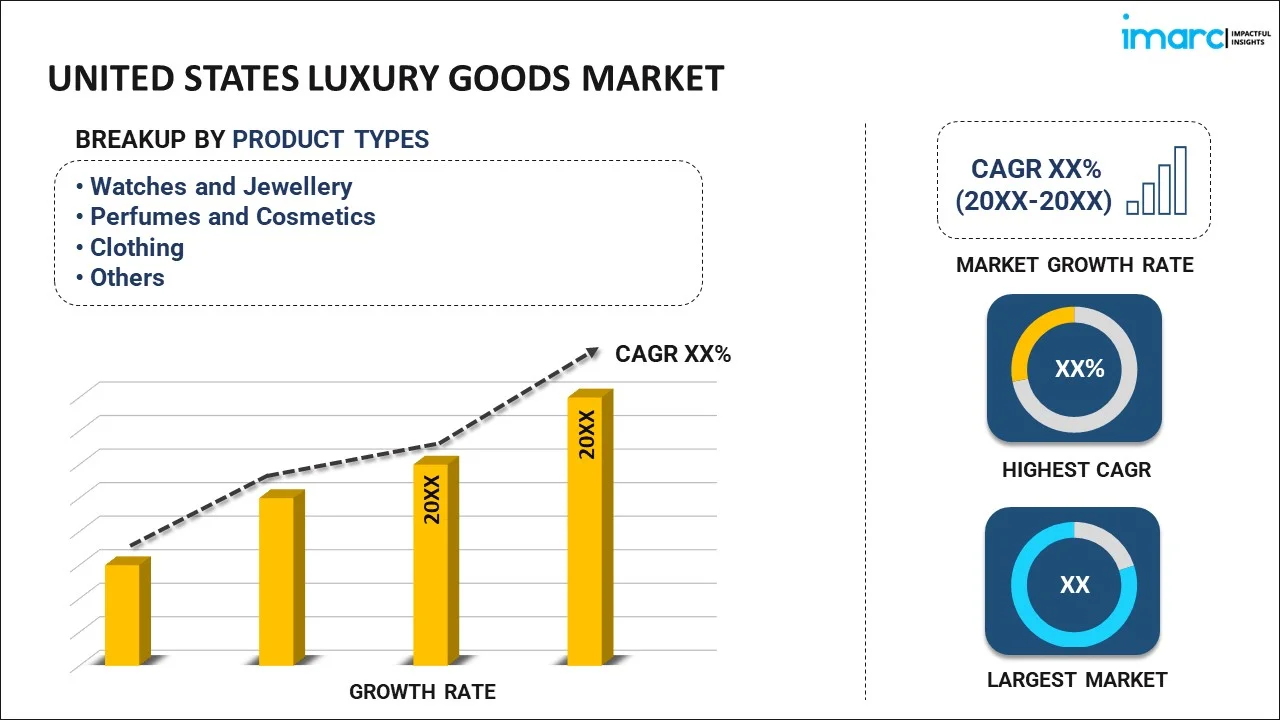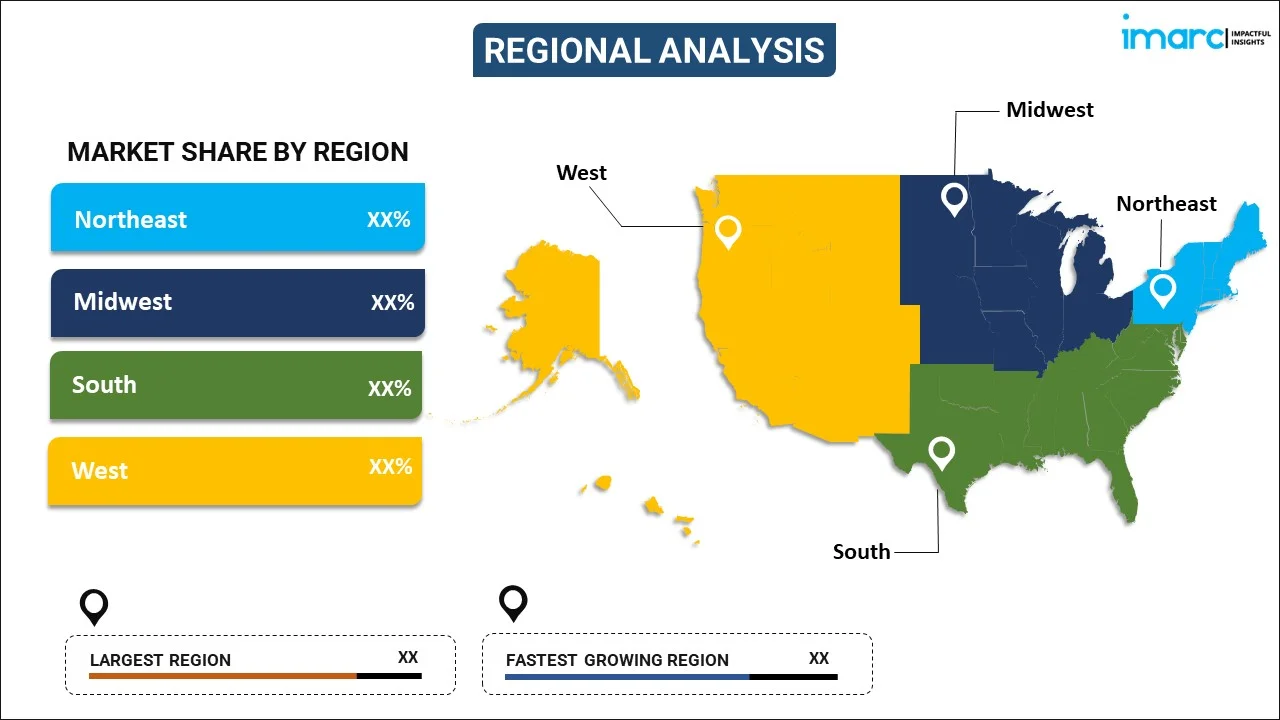
United States Luxury Goods Market Report by Product Type (Watches and Jewellery, Perfumes and Cosmetics, Clothing, Bags/Purse, and Others), Distribution Channel (Offline, Online), End User (Women, Men), and Region 2025-2033
Market Overview:
United States luxury goods market size reached USD 67.9 Billion in 2024. Looking forward, IMARC Group expects the market to reach USD 108.5 Billion by 2033, exhibiting a growth rate (CAGR) of 5.3% during 2025-2033. The increasing demand for online marketing, social media, and e-commerce platforms, which provide new avenues for brand exposure and sales, is driving the market.
|
Report Attribute
|
Key Statistics
|
|---|---|
|
Base Year
|
2024 |
|
Forecast Years
|
2025-2033
|
|
Historical Years
|
2019-2024
|
| Market Size in 2024 | USD 67.9 Billion |
| Market Forecast in 2033 | USD 108.5 Billion |
| Market Growth Rate (2025-2033) | 5.3% |
Luxury goods epitomize opulence, exclusivity, and craftsmanship, transcending mere material possessions to become symbols of prestige and sophistication. These items, often associated with high-end brands, reflect a fusion of artistry and functionality. From haute couture fashion and exquisite timepieces to lavish automobiles and designer accessories, luxury goods cater to discerning individuals who seek the epitome of quality and elegance. Consumers of luxury goods are drawn not only to the product itself but to the rich heritage and brand narrative that accompanies it. The allure of owning a luxury item lies in the sense of exclusivity, as these products are often produced in limited quantities, reinforcing the idea of rarity and prestige. Beyond the tangible aspects, luxury goods embody a lifestyle and identity, providing a gateway to a world where sophistication, refinement, and a commitment to excellence reign supreme.
United States Luxury Goods Market Trends:
The luxury goods market in the United States is driven by several key factors that collectively contribute to its sustained growth and dynamism. Firstly, the rising regional disposable income, coupled with an expanding affluent consumer base, has significantly propelled the demand for luxury products. As incomes soar, consumers are more inclined towards premium and exclusive offerings, fostering a positive trajectory for the luxury goods sector. Furthermore, the increasing influence of social media and digital platforms has become a pivotal driver, amplifying brand visibility and desirability. Moreover, evolving consumer preferences and a growing emphasis on experiential luxury have reshaped the market landscape. Luxury goods are no longer merely tangible products; they embody a lifestyle and status, aligning with consumers' desire for unique, personalized experiences. In addition to this, the expansion of e-commerce has further democratized access, allowing consumers from diverse regions to indulge in premium products with ease. Additionally, strategic collaborations and brand partnerships have become instrumental in driving innovation and captivating consumer interest. Luxury brands often collaborate with renowned designers, artists, or celebrities, creating limited-edition collections that fuel exclusivity and elevate brand allure. In essence, the luxury goods market in the United States is a multifaceted realm where income growth, digital influence, changing consumer preferences, and strategic collaborations converge to shape its ever-evolving landscape.
United States Luxury Goods Market Segmentation:
IMARC Group provides an analysis of the key trends in each segment of the market, along with forecasts at the country level for 2025-2033. Our report has categorized the market based on product type, distribution channel, and end user.
Product Type Insights:

- Watches and Jewellery
- Perfumes and Cosmetics
- Clothing
- Bags/Purse
- Others
The report has provided a detailed breakup and analysis of the market based on the product type. This includes watches and jewellery, perfumes and cosmetics, clothing, bags/purse, and others.
Distribution Channel Insights:
- Offline
- Online
A detailed breakup and analysis of the market based on the distribution channel have also been provided in the report. This includes offline and online.
End User Insights:
- Women
- Men
The report has provided a detailed breakup and analysis of the market based on the end user. This includes women and men.
Regional Insights:

- Northeast
- Midwest
- South
- West
The report has also provided a comprehensive analysis of all the major regional markets, which include Northeast, Midwest, South, and West.
Competitive Landscape:
The market research report has also provided a comprehensive analysis of the competitive landscape. Competitive analysis such as market structure, key player positioning, top winning strategies, competitive dashboard, and company evaluation quadrant has been covered in the report. Also, detailed profiles of all major companies have been provided.
United States Luxury Goods Market Report Coverage:
| Report Features | Details |
|---|---|
| Base Year of the Analysis | 2024 |
| Historical Period | 2019-2024 |
| Forecast Period | 2025-2033 |
| Units | Billion USD |
| Scope of the Report | Exploration of Historical and Forecast Trends, Industry Catalysts and Challenges, Segment-Wise Historical and Predictive Market Assessment:
|
| Product Types Covered | Watches and Jewellery, Perfumes and Cosmetics, Clothing, Bags/Purse, Others |
| Distribution Channels Covered | Offline, Online |
| End Users Covered | Women, Men |
| Regions Covered | Northeast, Midwest, South, West |
| Customization Scope | 10% Free Customization |
| Post-Sale Analyst Support | 10-12 Weeks |
| Delivery Format | PDF and Excel through Email (We can also provide the editable version of the report in PPT/Word format on special request) |
Key Questions Answered in This Report:
- How has the United States luxury goods market performed so far and how will it perform in the coming years?
- What has been the impact of COVID-19 on the United States luxury goods market?
- What is the breakup of the United States luxury goods market on the basis of product type?
- What is the breakup of the United States luxury goods market on the basis of distribution channel?
- What is the breakup of the United States luxury goods market on the basis of end user?
- What are the various stages in the value chain of the United States luxury goods market?
- What are the key driving factors and challenges in the United States luxury goods?
- What is the structure of the United States luxury goods market and who are the key players?
- What is the degree of competition in the United States luxury goods market?
Key Benefits for Stakeholders:
- IMARC’s industry report offers a comprehensive quantitative analysis of various market segments, historical and current market trends, market forecasts, and dynamics of the United States luxury goods market from 2019-2033.
- The research report provides the latest information on the market drivers, challenges, and opportunities in the United States luxury goods market.
- Porter's five forces analysis assist stakeholders in assessing the impact of new entrants, competitive rivalry, supplier power, buyer power, and the threat of substitution. It helps stakeholders to analyze the level of competition within the United States luxury goods industry and its attractiveness.
- Competitive landscape allows stakeholders to understand their competitive environment and provides an insight into the current positions of key players in the market.
Need more help?
- Speak to our experienced analysts for insights on the current market scenarios.
- Include additional segments and countries to customize the report as per your requirement.
- Gain an unparalleled competitive advantage in your domain by understanding how to utilize the report and positively impacting your operations and revenue.
- For further assistance, please connect with our analysts.
 Inquire Before Buying
Inquire Before Buying
 Speak to an Analyst
Speak to an Analyst
 Request Brochure
Request Brochure
 Request Customization
Request Customization




.webp)




.webp)












